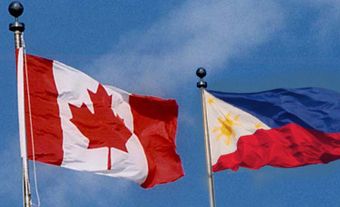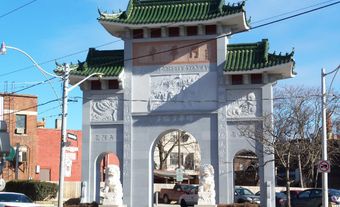Toronto’s Little Manila is situated in the central district of North York. Toronto's Little Manila is found along two major streets: Bathurst Street (running north-south) and Wilson Avenue (running east to west). The area is generally associated with the Filipino business community. The commercial main street is recognized to be of cultural heritage significance to the City of Toronto as a distinct ethnic and cultural hub.
Migration and Settlement
First Nations were present in the area today called North York for millennia. The district is located within the boundaries of Treaty 13, signed with the Mississaugas of the Credit. Before the Second World War, the area around Bathurst and Wilson was mostly rural. It gradually expanded as the Jewish community settled there in suburban houses during the post-war period. In the 1950s, many Jewish cultural and learning centres (as well as synagogues) were built, especially along the Bathurst Street corridor.
Starting in the 1960s, Toronto’s Filipino population grew in size. At the time, Canada’s immigration policy reforms allowed many Filipino immigrants to come to Canada. (See Immigration to Canada.) The economic situation in the Philippines also encouraged many to migrate. The downtown neighbourhood of St. James Town became a starting point for many immigrant workers. Toward the 1990s, there was a sharp increase in Filipino migration. Thousands of Filipino women arrived as domestic workers, sponsored by families who needed live-in caregivers. Others found work in the neighbourhood of Baycrest Centre as caregivers for ageing members of the Jewish community.
Many Filipino immigrants sponsored their family’s immigration to Canada. Since 2011, the Philippines has been one of the largest sources of immigrants to Canada. As a result, the Filipino community kept growing.
According to the 2016 census, 274,670 people of Filipino ethnic origin live in and around Toronto. The area near Bathurst Street and Wilson Avenue has the highest concentration of residents of Filipino ethnic origin in the city. Tagalog (Filipino) is one of the top spoken home languages in the area. (See also Languages in use in Canada.) Since the early 2000s, the transformation of Toronto’s Little Manila is the result of increased Filipino immigration in the area. There, the community reconfigured the neighbourhood into local businesses servicing the Filipino community.
Economic Life
The area bounded by Bathurst Street and Wilson Avenue has one of the highest median income levels in Toronto. (See also Income Distribution.) Employed Filipino immigrants tend to report higher labour force participation rates than other immigrant populations. However, the gap in incomes among community members is still wide. This is partly due to low-paying jobs in health care, hospitality and manufacturing. Moreover, most workers prioritize sending money or care packages back to their relatives in the Philippines. They usually do so through the services of remittance centres called balikbayan boxes.
Did you know?
In Philippine English, balikbayan refers to a person returning to the Philippines after a period of time abroad.
Housing is a major concern for many Filipino community members. Some Filipino live-in caregivers are unable to afford housing outside of their employer’s home due to inadequate compensation. Others keep housing costs low by staying in weekend apartments. Housing inequality remains one of the issues that members of the community face in the area.
Over the years, increasing numbers of Filipino residents established variety stores, bakeries and restaurants. Some businesses operate on their own while others rent space in existing strip malls. These stores vary from short-term tenants to long-term entrepreneurs at the same location for several years. Few attempts have been made to form a Business Improvement Area (BIA) in partnership with the city. A BIA allows a group of property owners and tenants to join together to promote the area as a business and shopping district.
Over the years, Filipino investors poured money into the area. In 2019, fast food chain Jollibee opened their third Toronto branch in the neighbourhood.
Social and Cultural Life
Toronto’s Little Manila continues to be a major reception area for new immigrants, creating a vibrant urban mixture of peoples and cultures. During the month of June, members of the community celebrate Filipino Heritage Month. (See Filipino Canadians.) In Little Manila, it consists of parades and festivities including the annual Salu-Salo community picnic in nearby Earl Bales Park.
Tens of thousands of people attend the Taste of Manila festival. Every year since 2014, a stretch of Bathurst Street is usually closed off from vehicle traffic for the festivities. There, people can try Filipino street food and watch live entertainment. Other services are also offered such as immigration consulting, financial assistance, international money transfers and employment support. Organizers have called it the largest Filipino cultural event outside the Philippines. In July 2022, a part of Bathurst Street was closed to vehicle traffic to host a similar street festival called Fun Philippines.
The Our Lady of Assumption Parish, located south of Little Manila along Bathurst Street, serves the Filipino community in the area. Since August 2008, it’s been the designated Filipino chaplaincy in Toronto. The parish offers Filipino-language mass every week. (See Catholicism in Canada.) Similarly, the Barbara Frum library branch is also south of Little Manila but serves the community with programming catered to Philippine-born newcomers. The library has one of the largest collections of Tagalog materials in Toronto. There are several schools serving both elementary and secondary students in the area. Baycrest Public School and St. Margaret Catholic School both notably have a significant number of Filipino students.
Politics
Filipino Canadians are active in political affairs in both Canada and the Philippines. Bathurst-Wilson Parkette acts as a major node of activity in the area. The green space serves as a convenient meeting point for the community. There, the Philippine flag is hoisted at least once a year to mark the country’s Independence Day. At times, it serves as a gathering point for protests, demonstrations and political rallies. Spontaneous vigils also take place.
Community members have sought to establish a demarcated Filipino neighbourhood. In 2013, a grassroots group was created to define the area of Bathurst and Wilson as a “Filtown” or Filipino town. Instead, people call the area “Little Manila” because of the popularity of the Taste of Manila festival. There are other Little Manilas across North America, predominantly in the United States.
Heritage
Within close proximity to Little Manila, a number of landmarks recognize the Filipino community’s presence in the area. The statue of Dr. Jose P. Rizal by F.B. Caede was given by the Philippine government to the City of Toronto. Rizal was a key role actor in the Philippine independence movement. The statue was installed in Earl Bales Park during the centennial celebration of Philippine Independence Day in 1998. In 2022, the National Historical Commission of the Philippines unveiled a special marker at the park celebrating Rizal’s 161st birth anniversary.
In 2016, a portion of the Bathurst-Wilson Parkette was named Mabuhay (Welcome) Garden. Toronto Councillor James Pasternak led the dedication to recognize the Filipino community’s presence in the area. Renovations of the garden added additional seating, a pergola and new landscaping designed by horticulturist Heidi Weidelich. Some flowering plants similar in look to Philippine hibiscus were selected.
In 2018, Toronto street artist Nick Sweetman completed murals along Bathurst Street and the span of Highway 401. (See Iconic Highways in Canada.) His works depict animals from different parts of the world to represent the area’s largest cultural groups, including Jewish, Russian and Filipino. There are birds found in Canada next to the Philippine eagle. The underpass mural was unveiled during the 2018 Taste of Manila Festival.
Just as these applied arts are remarkable, some have captured the spirit of Little Manila in other art forms. Suman Ladies, a 2012 short film directed by Althea Balmes, depicted the life of a street food vendor in the neighbourhood. Writer Jennilee Austria captured the struggles of Filipino immigrant youth in her short story Belonging at Bathurst and Wilson. The story was one of the winners of the 2017 Ontario Book Publishers Organization's writing contest.
For several years, Heritage Toronto and Jane’s Walk guides offer tours to the public to experience the ongoing transformation of the neighbourhood's culture and cuisine.

 Share on Facebook
Share on Facebook Share on X
Share on X Share by Email
Share by Email Share on Google Classroom
Share on Google Classroom



